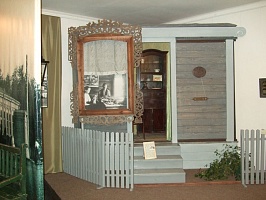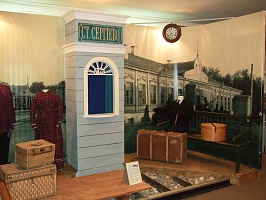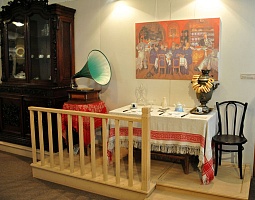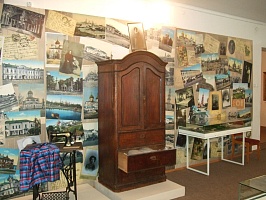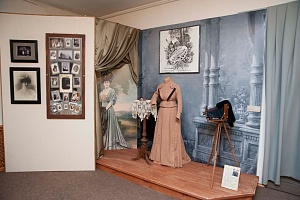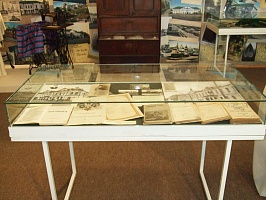Wednesday – Sunday 10 00 – 18.00
Ticket for 1 exhibition or exhibition:
- adult - 160 rubles.
- preferential - 80 rubles.
Photo and video shooting in the museum premises on the visitor's equipment (photo or video camera), without using a flash, tripod and monopod
- Photo - 170 rubles/person.
- Video - 230 rubles/person.
Exhibition “At the Trinity in Sergiev Posad”
n 1862, when the Trinity railway was opened, there were only four stations: Mytishchinskaya, Pushkinskaya, Talitskaya (now Sofrino), Khotkovskaya – and two terminals. In 50 years they constructed more platforms: Perlovskaya, Taininskaya, Tarasovskaya, Klyazma, Mamontovskaya, etc. At the beginning of the 20th century, the 3-d class ticket price was 80 kopecs, that was two times cheaper than the cheapest ticket in the passenger-and-mail carriage. The passengers were pilgrims, businessmen from Sergiev Posad, professors of the Moscow Theological Academy, students, industrialists.The exhibition begins in the foyer, where you can read information about the railway, see a view of Moscow of the mid-19th c. and a real pillar with posters of the early 20th century.
Climbing the stairs, you can set out on an imaginary travel by train to Sergiev Posad, passing by the stations and platforms (presented in the photographs of that time).
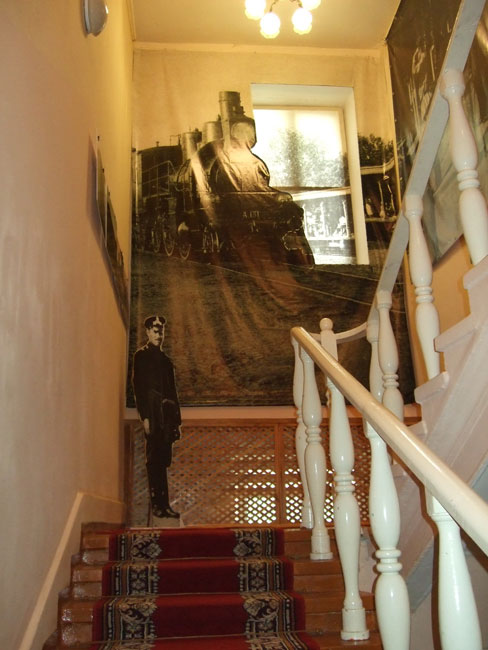
The first hall
So you reach Sergievo station. Here you can see the reconstruction of the railway station in Sergiev Posad (the building is still used as the station), maquette of a ticket window and models of passengers with contemporary baggage and travelware.In the show-case one can see travel accessories of the early 20th century – One-way 2-d class ticket, leather PURSE, paper money, copper COINS, COUNTING FRAME, a SMALL GLASS in a case, PENCIL in a metal pencil case, FOLDER, double-sided PENCIL, leather BELT with a buckle “North R.”, PINCE-NEZ, travel ICON, DISCRIPTION of the Holy Trinity-St. Sergius Lavra, POST-CARDS with the Lavra views.
The town, spreading around the Trinity-St. Sergius Lavra at the beginning of the 20th century, combined the crowded center and quiet green back streets of cozy houses with carved window-frames. There lived craftsmen. Most of them were connected with pilgrim service. Every day a lot of people arrived in Sergiev Posad. The guests spent here one or three days and stayed at the place they could afford. There were hotels, pilgrim hostels and private houses providing furnished rooms or beds. (The maquette of the facade of the town house is demonstrated). For the Sergiev Posad inhabitants lodging was an important part of income alongside with trade and toy and souvenir production..
Hall 2:
At the beginning of the 20th century, Sergiev Posad was a major town in the Moscow Province. It had several industrial enterprises and developed handicrafts, including toy production. The town with population of over 20 thousand had about 250 various small shops, shops, taverns, pubs, storehouses. The Pancakes Yard was one of the establishments bringing income to the town. It paid land fee and taxes to the town treasury. The Pancakes Yard was under the hill behind the Chapel of the Pyatnitsky Well. The guests, who liked tasty meals of the hospitable hostesses, used to say: “If you did not taste pancakes, you did not really visit Sergiev Posad”..
One of the walls in the second hall is occupied by a poster with ancient photographs of the town citizens, post-cards and letters. The poster is the background of the exhibition complex showing a milliner atelier of the 20th century “EVERYTHING FOR DRESS-MAKING” (reconstruction).
Exhibits: catalogues of textiles, early 20th century, France; jacket (velvet, beads); samples of textiles produced by I.F. Zyatsev’s factory; sewing accessories: a needle bank, scissors, buttons, thimble, lace, ribbons and “Zinger” treadle sewing machine.
You can also see a fragment of A.P. Platonov’s Photographic Studio (reconstruction). A.P. Platonov worked at the turn of the 20th century. The Photographic Studio was in the annex of the “new” hotel in Alexandrovskaya (now Karl Max) street. Subsequently Platonov bought a wooden house in Petropavlovskaya street (the 1st Shock Army street). The second floor was arranged as Platonov’s private photographic studio, where the owner created portraits of the local residents and made photoes ordered by the Lavra. Platonov photographs received international awards: 1904 – Silver medal at the exhibition in Paris; 1905 – Silver medal at the exhibition in Liege (Belgium); 1906 – Highest reward at the International exhibition in Milan (Italy).
The Krasnogorsky market offered a variety of goods. For the reading public, and there were quite a lot of educated people in Sergiev Posad, there were book shops in the rows of shopping stalls. Among them M.S. Elov’s shop in the New Row of Stalls was most popular. Elov sold books partially printed in the local printing houses, post-cards with the views of the Lavra and Sergiev Posad, commissioned by his shop.









